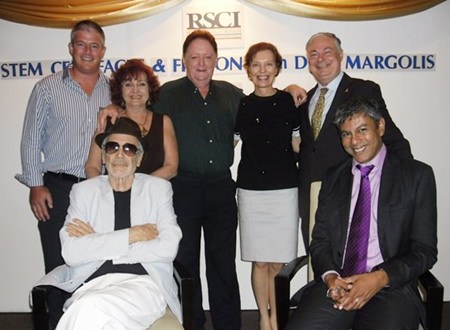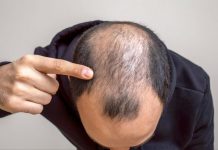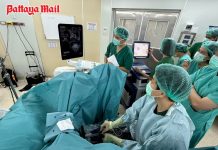The South African Chamber of Commerce offered a glimpse into the world of stem-cell therapy at a seminar in Bangkok.
Don Margolis from Repair Stem Cells Institute in the United States was the featured speaker at the Aug. 20 workshop at the Rembrandt Hotel & Towers, lecturing on the “facts and fiction” about stem cells.
Margolis stated that stem-cell therapy might become the healing method of the future. Meanwhile, major successes have already been made with cancer or problems with the heart, the lungs, the vocal cords, brain, kidneys, and blood. Unfortunately, there are no significant successes in liver disease or bone disease. In this therapy stem cells are used and for many years is the treatment of choice for various types of cancers, such as leukemia. Either endogenous hematopoietic stem cells or those of a donor (postnatal tissue) can be used for adoptive cell transfer.
 Group photo (front seated from left) guest speaker Don Margolis and Ragil Ratnam of Pure Growth Asia. (Standing from left) Antony Brown, Chartering Executive of Light House navigation, Elfi Seitz, executive editor of Pattaya Blatt, Allan Riddel, Linda Reay Amazon Colours and General Manager Eric Hallin.
Group photo (front seated from left) guest speaker Don Margolis and Ragil Ratnam of Pure Growth Asia. (Standing from left) Antony Brown, Chartering Executive of Light House navigation, Elfi Seitz, executive editor of Pattaya Blatt, Allan Riddel, Linda Reay Amazon Colours and General Manager Eric Hallin.
These multipotent blood stem cells, of which colonies of both white as well as red blood cells were cultivated, had already been discovered in 1963 by the Canadian scientists James Till, Ernest McCulloch and Lou Siminovitch. Some years before the first bone marrow transplant was performed in 1957.
Since the 1990s, many more kinds of stem cells were discovered, isolated and characterized. To date, however, is not sufficiently clear how the different types of stem cells are connected and which biological potential they have. In recent years new discoveries have been made in this area and new and promising fields in medical research have been opened. It is also possible to use stem cells from unborn animals (prenatal tissue), such as sheep, as is done in Germany for the last 70 years. For this, however, the embryo may only be a certain age, because the stem cells usually have a lower rate of division and a more limited differentiation potential. It’s also possible to get stem cells from the umbilical cord or bone marrow. Embryonic stem cells are pluripotent, whilst adult stem cells probably have a more limited differentiation potential.
Research work is currently still trying to answer fundamental questions like how these stem cells can be induced into certain cell types to replace damaged tissue in order to replace damaged tissue (cell replacement therapy). Other issues include the migration behavior (migration of the cells to a specific location after successful transplantation) or the formation of cell-protective factors (cytokines, growth factors), which are supposed to preserve existing functional tissue from further decline or even regenerate it (regenerative medicine).
In recent years embryonic stem cells have raised many ethical as well as scientific concerns (embryonic stem cells). Although they can be differentiated in almost all body cells (and thus would be universally applicable), for the time being their use is limited. This is due to their high rate of cell division, which is desirable for the propagation of the cells, but at the same time constitutes an increased risk for the development of malignant tumors.
Still, more than 300 Parkinson’s patients have been treated with some success worldwide.
Stem cells from the uterine fluid were isolated just recently. They are mostly cells of epithelial origin that are shed during the development of the fetus. They can be obtained directly from the amniotic fluid and be propagated in vitro.
Currently, in only a few cases a transplant of stem cells is performed. These therapies have been tried for many years, even decades, in controlled clinical trials, and are only used when they proved to be effective and the benefit outweighs the possible side effects.
Many patients, who are inflicted with severe, fatal diseases hope for a successful treatment in private hospitals, which promise healing with often risky types of application (eg injection into the brain – with often grave results) of scientifically undefined stem cells. Most of these clinics are located in countries with less strict rules concerning experimental therapies for humans (as in China, the Ukraine, Turkey and also in Thailand), but also in Western Europe (eg. the Netherlands).
However, as Margolis pointed out during the lecture, the stem cell treatment might have no affect in as many as one of three people. To protect patients from rogue, potentially damaging stem cell treatments or to inform about these, the International Society for Stem Cell Research has created a patient brochure.




